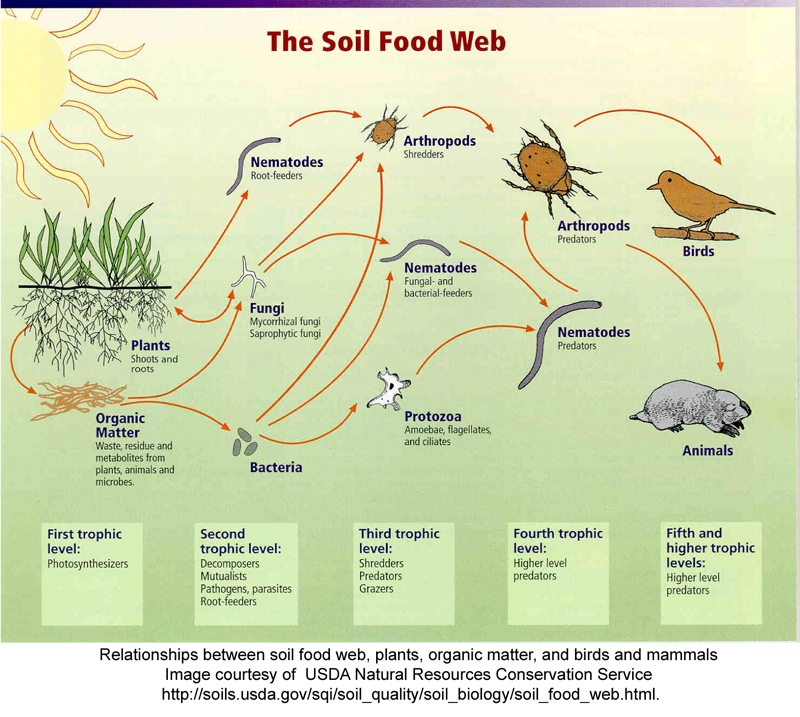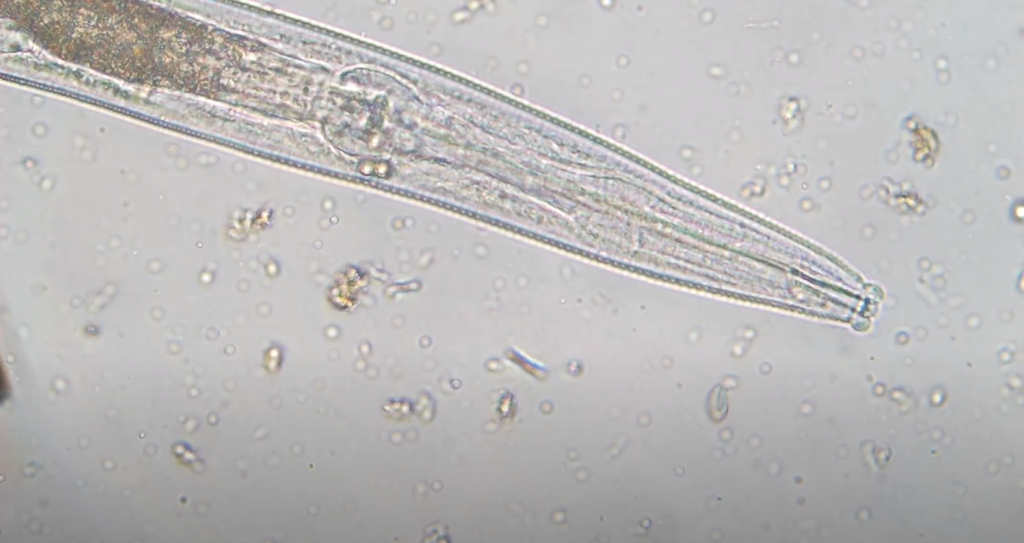By Christine Gust
Note: You may learn more about soil biology from Christine on January 24, 2024, when she hosts a Wild Ones Front Range webinar on soils and native plants. Registration details will be published in the upcoming weeks.
Plants use sunlight to convert carbon dioxide into energy (sugars). Plants release some of these sugars and other nutrients from their roots into the soil (where they are called exudates). This attracts and feeds microbes, primarily bacteria and some fungi. Bacteria are like the mice of the soil food web– you need lots of them because so many other critters eat them. But, if you only have bacteria (i.e. mice), that’s not a balanced ecosystem. You need their predators to keep them in check. When microbes poop or die, nutrients are released into the soil in a form that plants can use. Therefore there’s a cycle with the plants feeding the microbes and microbes feeding plants.

This article provides an overview of the needs of soil microbes and some specific practices to consider when growing native plants. Most modern practices deplete the biology in soil because we didn’t understand the role and importance of a healthy soil food web. Healthy soil reduces water usage, protects plants against pests and disease, controls weeds, and increases overall plant health and productivity. It’s important to care for the soil food web in all types of gardening and farming, but the implementation can vary depending on the goals. For example, growing plants native to our region will require different implementation from that for annual vegetables and it’ll be different again for an orchard.
In addition to bacteria and fungi, there are larger predators–shown in the diagram to the left–which are in turn prey for others. Each death cycles nutrients, releasing them for other uses, in many cases our plants.
Although bacteria, fungi, protozoa, nematodes and microarthropods are too tiny to see without a microscope, there can be billions of them in a teaspoon of healthy soil. We need to keep them healthy to keep the soil food web healthy. Just like above-ground living beings, soil microbes need:
• Air
• Water
• Food
• Shelter
• Minimal disturbance
When there is a robust and balanced soil food web, the soil holds more air, water, and nutrients so the plants receive more nutrients and are healthier, more productive, and can withstand environmental stresses better.
That seems reasonable, but there are some challenges for accomplishing this in our region. As a lab technician certified through the Soil Food Web school, I work with local farmers and gardeners to help them improve the quality and health of their soil. I use a microscope to estimate the quantity of beneficial and detrimental micro-organisms in their soil and provide recommendations to improve and balance the biology.
Along the Front Range and in other areas of Colorado, some typical challenges include:
• The ground is compacted and dominated by expansive-clay content.
• There is a low organic matter content (typically <3%).
• The soil tends to be excessively alkaline.
• There’s relatively little rain, only about 8-15 inches per year.
Fortunately, our native plants are adapted to grow in these conditions! However, you can do more to help by following these practices:
Reduce compaction and disturbance- Compaction reduces the ability of the soil to permit oxygen to permeate. This fosters anaerobic bacteria which are less healthy for the system and decreases the amount of water soil can absorb. To minimize this problem, don’t walk on your soil; make dedicated pathways and leave the rest of the garden undisturbed. If your ground is already compacted, use a broadfork or garden fork to gently loosen soil, allowing air and water to infiltrate. Another alternative is to build berms using clean fill dirt because it has low organic matter, and most of our native plants can grow well in this lean soil. The berms allow for good drainage so the plants don’t sit in a pool of water. While rototilling seems like it decreases compaction, the estimate is that it kills more than 50% of the microbes each time and actually creates a compaction layer below the tilled area, so it doesn’t usually make sense to use this approach unless you follow that with an application of biologically active compost extract to re-inoculate the ground with microbes.

Keep soil covered to protect microbes from the elements and minimize water loss. Nature doesn’t leave bare ground for long, and weeds are simply pioneer plants doing their job to cover the ground. You can keep the ground covered using plants (Can there be too many?!) or mulching with an appropriate material for the type of plants. Wood chips or dried leaves provide food to grow beneficial fungi and build soil structure but can cause some of our native plants to rot at the crown. Consider pea gravel for most native plants instead.
Note: Rain falling on bare ground is one of the biggest contributors to compaction, so keeping the soil covered also resolves this issue.
Chemicals commonly used to manage weeds and pests kill microbes as well and should be avoided. Dr Elaine Ingham, founder of the Soil Food Web school, notes that if plant surfaces (leaves, roots, stems) are covered with beneficial microbes, diseases cannot get to foliage or roots, and any problem organisms are consumed and outcompeted by beneficial microbes. Also, buy pesticide-free plants for the same reason.
As you’re thinking about chemicals, consider that our municipal water is treated with chlorine or chloramine, which are chemicals used to kill microbes. Of course, we don’t want them growing in our plumbing, but since we do want microbes in our soil, implement strategies to slow, spread and store rainwater so you can minimize supplementing with municipal water. The low water needs of most of our native plants is another advantage of growing them. If you do need to water, you can attach a dechlorinating filter to your garden hose or add ascorbic acid (vitamin C) to water to neutralize chlorine/ chloramine.
If you need to remove any plants from your garden, consider cutting them off at the ground level and leaving the roots in the ground. While they are decomposing, they can also serve as a “food pantry” for microbes in the area.
Soak seeds and the roots of young plants in a compost extract at the time of planting to inoculate them with beneficial microbes.
If you have an overgrowth of weeds, that is most likely an indicator that the soil food web is out of balance and that you primarily have bacteria in your soil. As noted earlier, bacteria are like the mice of the soil food web. There needs to be a lot of bacteria (like mice) because so many other critters eat them. However, bacteria release a form of nitrogen that is NO3–, nitrate, which is the form that weeds mainly use. When predators are present in sufficient numbers (protozoa, nematodes and others as shown in the graphic), they release nitrogen in the NH4+, ammonium, form. Weeds can’t use the ammonium form as easily- they become weak, sick and/or die. The plants we want to grow generally prefer ammonium.
Grow a diversity of plants, including grasses and forbs, deep and shallow rooted species, perennials and biennials. Different plants affect the soil differently and may attract different microbes. What is true for life above the ground is also true for life in the soil. Monocultures do not exist in nature.
Leave the leaves. Not only do leaves provide habitat and food for larger organisms, they also provide shelter and food for microbes.
We still have a lot to learn about soil microbes and how they live in different ecosystems, such as agricultural vs native lands. But, if you care for your soil as a living community of beings, they will take care of your plants.
Christine Gust, an active Wild Ones Front Range member, earned her lab certification through Dr. Elaine’s Soil Food Web school, and her website is soiltransformations.com. She also has a permaculture design certification and worked at Harlequin’s Gardens Wholesale for several years.
————-
“Plants are in control of soil microbes, which they attract to their root zones. These microbes produce nutrients in inorganic form so they can be taken up by the plant.” — Jeff Lowenfels, Teaming with Bacteria
——————
To learn more about the soil food web, go to soilfoodweb.com. Select “Videos,” then click on “How It Works”
Curious to learn more about transforming your garden into a habitat with Colorado native wildflowers, grasses, shrubs, and trees? Check out our native gardening toolkit, register for an upcoming event, subscribe to our newsletter, and/or become a member – if you’re not one already!
